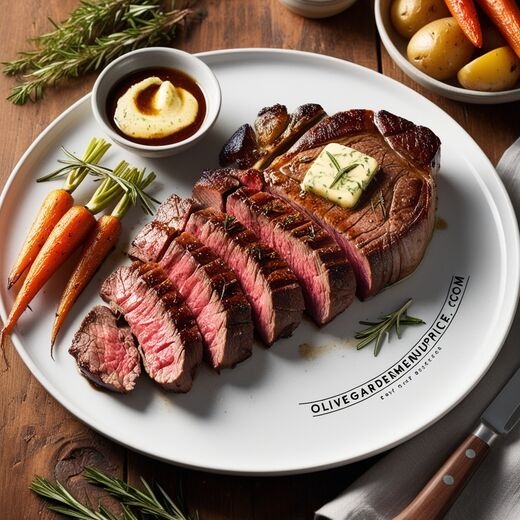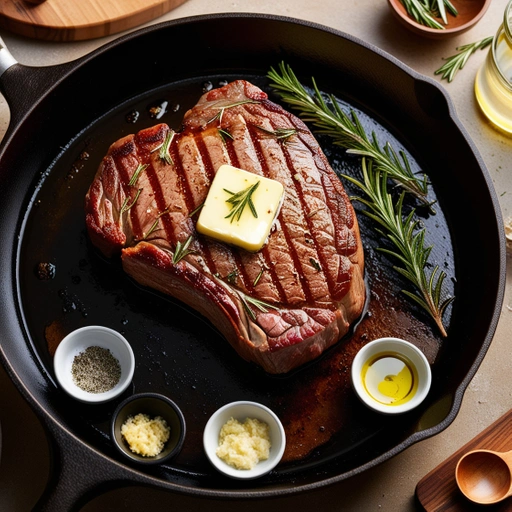
Making a medium-rare steak seems like an art, no matter whether you are an experienced cook or a beginner. Gaining control of this technique will give your meals a restaurant-like touch. However, worry not – you don’t need any excessive equipment or several years of practice to get it right. Just a few pointers from chefs and some practice on your part, and you will be preparing and serving delicious medium-rare steaks in no time. So, let’s break down the cooking process into each step and get started on its implementation. I’m Thomas Keller Head Chef of Olive Garden Restaurant. I am going to share with you my long experience of how to cook a medium-rare steak.
What Exactly Is Medium-Rare?
Let us address the most important aspect in this article first: what does medium-rare steak mean? When preparing a steak that you intend to serve it rare, you hope to reach an internal temperature of the meat, somewhere in the region of 130°F to 135°F (54°C to 57°C). The middle of the steak should be hot and pink while covered with a light brown layer. It is soft and succulent and most people’s favorite since it maintains the juices and fats to the right degree of cooking.
Step-by-Step Guide to Cooking a Perfect Medium-Rare Steak
1. Choose the Right Cut of Meat
Choosing the correct steak is crucial. This means cuts like ribeye steak, sirloin, filet mignon, or New York strip are perfect for cooking a medium-rare steak. These cuts have the right content of fat that the meat is said to be whining (because it makes the steak yummy and moist).
I suggest looking for a steak that has a thickness of not less than 1 inch. It is easier to cook thick steaks evenly which means that there is less probability of them being overcooked.
2. Let the Steak Come to Room Temperature
Bring the steak out of the fridge for about 20-30 minutes before cooking. This helps to ensure that an even cook is achieved. If a cold steak is placed straight from the fridge into the cooking pan, the outer side will be well cooked while the inner side is likely to remain raw.
3. Season Generously
Make sure to season your steak generously! I mean a simple touch of coarse salt and freshly cracked black pepper can make a huge difference. If that’s too bland for you, feel free to include garlic powder or better yet fresh herbs like rosemary or thyme. In this case, do not be shy in seasoning both sides.
I’m Chef Keller, and I have a different tip: using a paper towel, pat the steak dry before salting. This way the seasoning adheres better and you will get a nice seared crust.
4. Heat Your Pan or Grill
Regardless of the cooking medium – be it a cast iron skillet or a grill – turn the heat to the highest setting. The trick to achieving a perfectly cooked medium-rare steak is the great char on the outside which helps in keeping the meat succulent. If it is a frying pan, introduce a tablespoon or two of oil with a high smoke point such as canola or vegetable oil. Allow the oil to become very hot and slightly wavy, but not to the point that it smokes, and you may begin to prepare the dish.
5. Sear the Steak
When ready to cook the steak, put it in the pan or on the grill and let it sit for 3-4 minutes without moving it. It is time to turn the steak over when it comes off the grill or pan easily without any resistance and a golden brown crust covers the surface of the steak.
Turn the steak over and brown the second side for another 3-4 minutes. For those who love butter (and who does not?), one tablespoon of butter can be added to the pan while flipping the steak. Some cloves of garlic and herbs such as thyme may also be added to the butter for flavor enhancement.
6. Check the Temperature
For perfect doneness of the steak at a medium-rare inner level, I recommend you use an instant-read thermometer. Go ahead and insert it in the meatiest area of the steak. What is your target temperature? 130 degrees Fahrenheit to 135 degrees Fahrenheit. Otherwise, without a thermometer, the finger test can also be used to check how done the steak is. For medium-rare, a steak should feel like the fleshy part of the thumb at the base when you press the steak with the opposite hand.
7. Let It Rest
After your steak attains the ideal cooking temperature, take it off the flame and allow it to stand for a minimum of 5 minutes. Therefore, this standing phase enables the liquids supplanting the meat to be evenly spread within the flesh, making every mouthful as tasty as it can be.
8. Slice and Serve,
Cutting steak by the grain is the best way to achieve the tenderest pieces possible. Add your favorite side dishes as well – maybe some stuffed baked potato, barbecued veggies, or a crisp refreshing salad.
Special Tips for Cooking a Medium-Rare Steak
Tip 1: Use the Right Tools
When it comes to cooking steak at home, a cast-iron skillet is usually considered the best option. It holds heat well and gives the steak that great sear finish. If you are doing a grill, it is advisable to warm the grill up before putting on the steak.
Tip 2: Don’t over flip
Try not to succumb to the temptation of turning your steak more than once. Repeated flipping can lead to inconsistency in cooking and also stop that thick, brown crust from forming.
Tip 3: Resting Is Key
Letting your steak rest might appear to be a minor detail, but it contributes a lot to the taste. If you dig your knife into a steak before it has finished cooking, all those wonderful juices will flow out onto the plate rather than being savored in the mouth.
Tip 4: The Reverse Sear Method
For larger portions of meat, the reverse sear concept should be employed. It means cooking the steak in an oven for some time at low temperatures (generally, about 275°F) until it warms up to 110°F inside before completing the cooking process on an already heated surface like a frying pan or a barbeque i.e. imparting a nice crust.
Frequently Asked Questions (FAQs)
Q: What if I don’t have a meat thermometer?
A: You can use the finger test to gauge the level of doneness of your steak. In the case of medium-rare, the steak should be slightly pressed when touched but should not be too hard.
Q: Is it possible to bake a medium-rare steak?
A: Sure! For preparing a medium-rare steak in an oven, employ the reverse sear technique. This allows you to cook the steak entirely in the oven and then crisp the exterior on the stove.
Q: What can I do to make my steak more delicious?
A: You can add flavor to your steak by butter-basting in the last few minutes of the cooking process. Place garlic and herbs in the pan, then spoon over the steak with melted butter before completing the cooking process.
Q: What is the best method of reheating a steak in such a way that it does not get cooked again?
A: The best way to recover from this is to warm it in the oven at a low temperature and slow it down, but also scorch it lightly over the stove.
Conclusion
At first, grilling a steak to medium rare might seem a rather hard task, however, with a couple of practice it turns out to be an automatic reaction. This involves quite a lot – the choice of meat cut, the searing process, and focusing on the meat temperature, for example. Whether you are throwing a sumptuous dinner for your family or just pampering yourself, nothing can be as good as a well-cooked steak as an addition to any meal.
As such, wear your apron, warm up that skillet, and give it a go. We are sure you will be able to prepare incredible medium-rare steaks which one would expect in an expensive steak house in no time. And don’t forget practice makes perfect – the more you cook the better you get. Enjoy the cooking! if you have any problems please Contact us. I will try to solve your problem quickly.



Pingback: How to Cook Top Sirloin Steak: Advanced Tips and Tricks